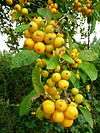Malus coronaria
| Malus coronaria | |
|---|---|
 | |
| A fruiting spray of M. coronaria | |
| Scientific classification | |
| Kingdom: | Plantae |
| (unranked): | Angiosperms |
| (unranked): | Eudicots |
| (unranked): | Rosids |
| Order: | Rosales |
| Family: | Rosaceae |
| Genus: | Malus |
| Species: | M. coronaria |
| Binomial name | |
| Malus coronaria (L.) Mill. 1768 | |
 | |
| Natural range | |
| Synonyms[1] | |
| |
Malus coronaria, also known by the names sweet crabapple or garland crab,[2] is a North American species of Malus (crabapple). It grows primarily in the Great Lakes Region and in the Ohio Valley, with outlying populations as far away as Alabama, eastern Kansas, Long Island, and Ontario.[3]
Malus coronaria often is a bushy shrub with rigid, contorted branches, but frequently becomes a small tree up to 10 meters (33 feet) tall, with a broad open crown. It prefers rich moist soil. Its flowering time is about two weeks later than that of the domestic apple, and its fragrant fruit clings to the branches on clustered stems long after the leaves have fallen.[4]
Subspecies
Malus coronaria var. coronaria
Malus coronaria var. dasycalyx
- list source :[2]
Description

- Bark: Reddish brown, longitudinally fissured, with surface separating in narrow scales. Branchlets at first coated with thick white wool, later they become smooth reddish brown; they develop in their second year long, spur-like branches and sometimes absolute thorns an inch or more in length.
- Wood: Reddish brown, sapwood yellow; heavy, close-grained, not strong. Used for the handles of tools and small domestic articles. Specific graity, 0.7048; weight of cubic foot, 43.92.
- Winter buds: Bright red, obtuse, minute. Inner scales grow with the growing shoot, become half an inch (12.5 mm) long and bright red before they fall.
- Leaves: Alternate, simple, ovate, three to four inches (7.5-10.0 cm) long, one and one-half to two inches (37–50 mm) broad, obtuse, subcordate or acute at base, incisely serrate, often three-lobed on vigorous shoots, acute at apex. Feather-veined, midrib and primary veins grooved above, prominent beneath. They come out of the bud involute, red bronze, tomentose and downy; when full grown are bright dark green above, paler beneath. In autumn they turn yellow. Petioles slender, long, often with two dark glands near the middle. Stipules filiform, half an inch (13 mm) long, early deciduous.

- Flowers: May, June, when leaves are nearly grown. Perfect, rose-colored, fragrant, one and one-half inch to two inches (37–50 mm) across. Borne in five or six-flowered umbels on slender pedicels.
- Calyx: Urn-shaped, downy or tomentose, five-lobed; lobes slender, acute, persistent, imbricate in bud.
- Corolla: Petals five, rose colored, ob ovate, rounded above, with long narrow claws, undulate or crenelate at margin, inserted on the calyx tube, imbricate in bud.

- Stamens: Ten to twenty, inserted on the calyx tube, shorter than the petals; filaments by a partial twist forming a tube narrowed in the middle and enlarged above; anthers introrse, two-celled; cells opening longitudinally.
- Pistil: Of five carpels inserted in the bottom of the calyx tube and united into an inferior ovary; styles five; stigma capitate; ovules two in each cell.
- Fruit: Pome or apple ripening in October. Depressed-globular, an inch to an inch and a half (25–37 mm) in diameter, crowned with calyx lobes and remnant of filaments; yellow green, delightfully fragrant, surface sometimes waxy. Flesh white, delicate and charged with malic acid. Seeds two or, by abortion, one in each cell, chestnut brown shining; cotyledons fleshy.[4]
History
Pehr Kalm, who was one of the twelve men whom Linnaeus called his apostles and sent forth to explore the vegetable world, wrote from America:
The apples, or crabs, are small, sour and unfit for anything but to make vinegar of. They lie under the trees all winter and acquire a yellow color. They seldom begin to rot before spring comes on.
See also
References
- ↑ Elizabeth E. Dickson (2015), "Malus coronaria (Linnaeus) Miller, Gard. Dict. ed. 8. Malus no. 2. 1768", in L. Brouillet; K. Gandhi; C.L. Howard; H. Jeude; R.W. Kiger; J.B. Phipps; A.C. Pryor; H.H. Schmidt; J.L. Strother; J.L. Zarucchi, Flora of North America North of Mexico, Volume 9: Magnoliophyta: Picramniaceae to Rosaceae, New York, Oxford: Oxford University Press
- 1 2 "Search results for: Malus". Retrieved September 11, 2009.
- ↑ http://bonap.net/MapGallery/County/Malus%20coronaria.png
- 1 2 3 Keeler, Harriet L. (1900). Our Native Trees and How to Identify Them. New York: Charles Scriber's Sons. pp. 133–135.
